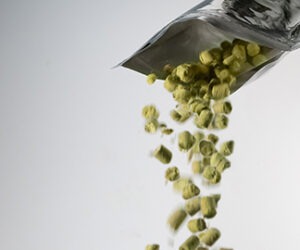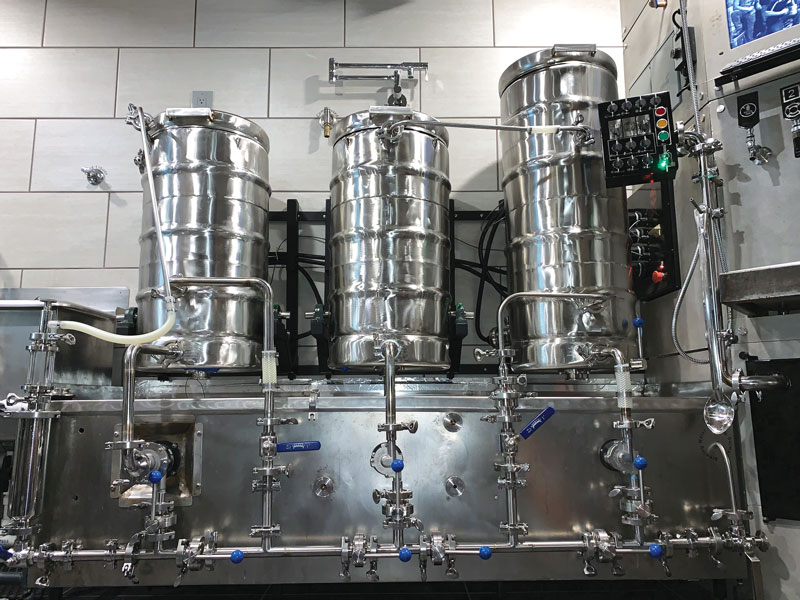The Beer That Drinks Like a Wine
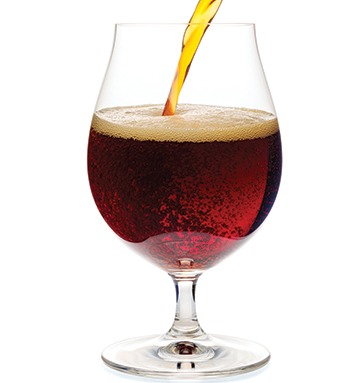
I started my book Brewing Barley Wines — Origins, History, and Making them at Home by defining the style. I thought this would be the easy part of this book before digging deep into its history, brewing ingredients and methods, and offering recipes for homebrewers. But the more I considered it, the less certain I became. The style seems to have had something of a murky past, with modern definitions being somewhat arbitrary. We do know, of course, that it is originally an English style, but one which has been taken up in relatively recent times by American craft brewers. There is a complete and rather long section in the book where I look at the history of the style and at modern versions of the beer and tried to determine what the parameters of the beer should be.
I’ll provide a definition, but I want you to understand that these defining measurements are my numbers and reflect my dislike of trying to pin down beer styles too precisely. I know I have written previously on putting numbers to beer styles in my books, but I have always regarded such attempts as mere guidelines — no one ever handed me stone tablets with specific instructions carved into them.
But, because numbers are required to understand styles, here you go:
OG = 1.080–1.140+ (20–32 °P)
FG = 1.025–1.035 (6.1–8.8 °P)
ABV = 8.5–13.5%+
IBU = 40–100
Color = Copper to dark red/brown
That is a rather broad description that includes a variety of beers (other than imperial stouts) with differing designations and which may not be regarded as barleywines by others. For example, double and triple IPAs would fit those parameters. Barleywines are best long matured so these IPAs would lose all their hop character on aging. They would then taste like a barleywine with a high hop bitterness. Indeed, I came across a double IPA from a local brewery and when I took a taste, I said “this is really a barleywine.” The brewer agreed with me and said he called it a double IPA because his customers preferred IPAs!
In making this broad definition, I looked at the history of the style and at commercial examples and concluded that there is a huge variation in strength and bitterness in these beers and that a broad definition was appropriate. Besides, when brewing for your own pleasure you do not want to be limited by more narrow definitions such as those espoused by the Beer Judge Certification Program (BJCP) — you only need to follow those when entering competitions.
My definition could include styles such as old and stock ales, audit ales, October and March ales, Burton ales, Scotch ales, some double and triple IPAs, and even wheatwine. I realize this selection is quite arbitrary and if you have doubts about my selections, read the first chapter in my book where I go into the matter more deeply.
One of the oddities about commercial barleywines is that they may not be named that at all. From England we have Thomas Hardy Ale, J.W. Lees’ series of Harvest Ales, and Fuller’s Vintage Ale.
Brewing Barleywines
Let’s get away from the what and look at how and why.
Grains: Pale malt is, of course, the basis of barleywine. If you are going to go the all-grain route, any good 2-row pale malt, U.S. or English, is fine. If you want to be as traditional as possible and use English malts then go with the Maris Otter variety (or even Golden Promise). I am not sure it really makes any difference as I have also had good results with American 2-row pale malt. It is advisable to use a malt that you know what extract it gives you on your brewing system because this will help to ensure that you meet your target original gravity (OG).
It is important in brewing a barleywine from all-grain that before you start you make sure that your mash tun can hold the required volume. For example, let’s assume that you want your barleywine to have an OG of 1.110, that you are going to sparge and collect a full 6–7 gallons (23–26.5 L) of wort, which you will boil down to 5 gallons (19 L), and that your brewhouse efficiency is 70%, so you will get a yield of 1.026/lb. (0.45 kg)/gallon (3.8 L). Then:
Total points required = 110 x 5 = 550
Weight of pale malt = 550 / 26 = 21.2 lbs. (9.6 kg)
That is a lot of grain that has to fit in your mash tun, and it will be accompanied by, say, 1.25 qts. (0.6 L) mash water per lb. grain, or 21.2 x 1.25 = 26.5 qt., or 6.6 gallons (25 L). That will be a total volume close to 10 gallons (38 L) and means you had better be sure that all this will fit into your mash tun before you start the brew. If you have only a 5-gallon (19-L) mash tun, you must obviously brew a lesser volume, 2.5 gallons (9.5 L) in the example above, or 3 gallons (11 L) at a lower original gravity. Check the volume of your mash tun by filling it with measured amounts of water. I know that is a bore and a pain, but you only have to do it once and it will avoid a lot of trouble down the road!
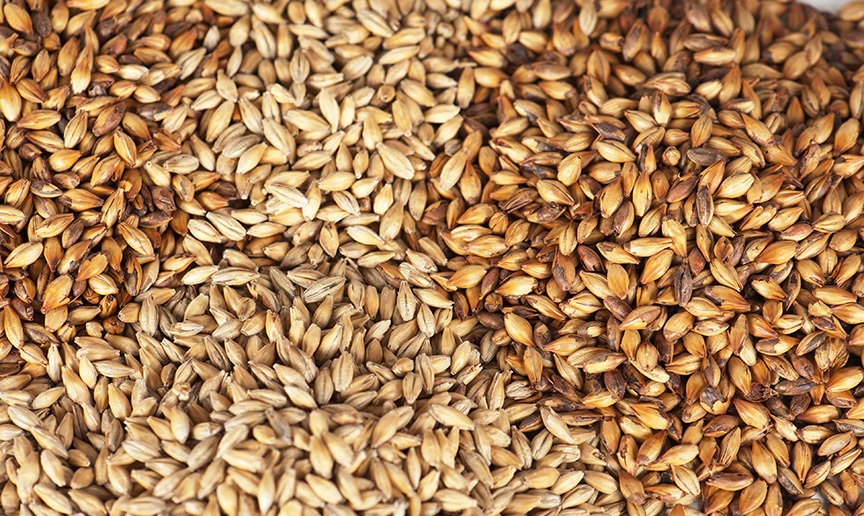
In fact, given that barleywine will be kept a long time and will be drunk only in small quantities and the work involved in handling such large amounts of grain, keeping to 2.5–3 gallons (9.5–11 L) is a good idea if you are new to the style. There are ways around this sizing problem if you do have a smaller mash tun, however, which I shall discuss later.
Caramel/crystal malts can be, and often are, included in a barleywine grain bill, although opinions differ about the wisdom or need to do so. The idea behind their use is to add some caramel and nutty flavors and, depending upon the caramel malt used, some red color hints in the finished beer. But such malts also contribute sweetness and some unfermentable sugar, both of which can make the finishing gravity of the beer higher than desirable. Caramel malts above 80 °L will be much redder in color, but can also be harsher in flavor and not, in my opinion, really suitable for barleywine. I would choose a 60 or 80 °L caramel malt if I were adding one, but some brewers prefer to use those at the lighter end of the range, say, 20–40 °L, since there is going to be significant color development due to Maillard reactions in a long boil, such as 3 hours or so as may be necessary in the basic method of barleywine brewing.
Malt extracts: If going the extract route, the first choice would be to use a pale extract to correspond with the pale barley malt used in all-grain brewing, especially if you wanted your barleywine to be on the pale side. Any good quality malt extract will be fine, but you should check with your supplier or the manufacturer as to exactly what yield a particular sample will give. Many brewers consider that Maris Otter grain malt is the best (and traditional) choice for barleywine, and there is a liquid extract available made only from Maris Otter. But if you want something darker in color, what do you do? You could, of course, steep a medium-grade of caramel malt (say 80 °L) in hot water at around 150 °F (66 °C) for 20 minutes or so, run the liquid into the boil kettle, rinse the grains again with hot water, add the rinses to the first running, then dissolve the malt extract and bring the wort up to boil volume.
Hops: Hop aroma and character are not necessarily a part of barleywine flavor and aroma. If these beers are to be long matured, perhaps for a year or more, then any hop aroma and character will have largely dissipated by the time the beer is drunk. Most of what you want from the hops is bitterness. I know that is something of a sweeping statement, and that some brewers, especially commercial brewers, might not wish to keep the beer so long before selling it. In fact, at Brewport Brewing Co., where I assist in brewing, we have matured a barleywine for just over a month before serving it on tap in the bar. That was partly because it was at the low end of the barleywine OG range (1.088) and partly because of limitations on tank availability, and we did put some of it into a couple of casks for longer aging. The point is that in the case of short maturation time you can late-hop or dry-hop your barleywine if you so wish.
But first, let’s deal with bittering hops, and a couple of basic points. First is that alpha acid extraction and isomerization are not very efficient processes in worts of very high specific gravity. Or to put it another way, hop utilization is low in barleywine. In an all-extract brew, you can improve utilization by adding a good part of the extract towards the end of the boil. The second point is that hop residues hold up some of the wort after the trub settles out at the end of the boil. This means that you want to use as small an amount of hops as possible to avoid such losses. Therefore, for bittering you should use only hops high in alpha acid, say at 10% alpha and above. This limits your choice somewhat, but for bittering purposes you do not need to be too picky regarding hop variety. Note that I am not saying that low alpha acid hops cannot be used in barleywines, because of course they have been, especially those brewed before the latter half of the twentieth century. I am simply saying that the most practical and efficient use of hops requires that they be high in alpha acids.
You can use any high-alpha variety from any source: American (such as Columbus, Centennial, Magnum, Warrior, etc.), English (such as Admiral), German (such as Magnum, Polaris, etc.), Australian (such as Galaxy®), or New Zealand (such as WaimeaTM and Green Bullet). Others you may consider are Galena (~12% alpha), Amarillo® (~11% alpha), Mosaic® (~12% alpha), Simcoe® (~11% alpha), Bravo (~13% alpha), Pacific Gem (~14% alpha), and so on. You might also consider Cryo® hops or other Type 45 pellet hops, which contain up to 26% alpha acids. Although most brewers use Cryo® hops for aroma these days, the original purpose of T-45 — or lupulin enriched — hops was to simply increase alpha acids by removing cone plant matter before pelletization. I have used Ekuanot LupuLN2® pellets as a bittering hop in brewing an all-extract barleywine at OG 1.094 with good results. At 22.8% alpha acids, it took only 1 oz. (28 g) in 4.7 gallons (18 L) for a nominal 90 IBUs, and gave a remarkably small amount of trub, minimizing wort loss on separation of the latter.
Calculating IBU levels is difficult because the utilization varies according to the gravity of the wort. Depending upon the brewing method used you will achieve only 10–15% utilization, so use the lower figure for OG above 1.110 and the higher value for OG 1.090–1.110 and plug this into whatever equation you use.
Yeast: Yeast plays a critical role in the brewing of barleywines. It can, of course, add flavors to the beer, depending upon the strain and on fermentation conditions. But the most important thing yeast must do in barleywine brewing is give good attenuation by pushing the final gravity down to less than 1.035, and preferably around 1.025, depending upon OG. In other words, you need it to ferment down to at least 70–75% of the OG or your beer will be cloyingly sweet, and the sweetness will overpower all other flavors. With most other styles and yeast strains this is not a problem, but in the case of barleywines the yeast is producing a lot of alcohol, to the extent that the alcohol can actually “poison” the yeast and inhibit it from forming more alcohol. That means that you need to pitch the wort with a lot of active yeast grown from a strain known to give good attenuation and ability to ferment high-alcohol styles.
What exactly does “a lot of active yeast” mean? Well, a commonly accepted requirement is to pitch with 1 million cells/mL/°P, (see, for instance, Barley Wine, Fal Allen and Dick Cantwell, 1998, Brewers Publications). For high-gravity beers a rate of 1.4 million cells/mL/°P is suggested in Yeast (Chris White and Jamil Zainasheff, 2010, Brewers Publications), and I would agree with that. This means that 5-gallons (19-L) of barleywine at 1.100 (23.8 °P) needs:
1.4 x 106 cells/mL/°P x 19 liters x 23.8 °P x 1,000 mL/L = 600 x 109 cells
That is 600 billion cells, and that is what I mean by “a lot of active yeast.”

Table 1 gives yeast requirements for different original gravities, rounded for convenience. Looking at the table, you’ll see a requirement of pitching about 6–8 packs of a liquid yeast, assuming 100 billion cells per pack. Further, these packs lose activity on storage so they need to be as fresh as possible. In practice, of course, you would not want to use so many packs and would probably prefer to make a starter.
Dried yeasts have the advantage of being quite stable when stored for long periods, losing perhaps only 10% of its activity over a year if stored in a refrigerator. One standard packet (11.5 g) contains about 200 billion active cells, so you would need 3-4 packets for a 5-gallon (19 L) brew if you are pitching it directly. Dried yeasts are generally less expensive on a single pack basis than liquid yeasts, so are even more economical on an active cell basis, so you may well be content to use four packs and not bother with making a starter. The disadvantage of dried yeasts is that not all strains are suited to the drying process, so there is a narrower range of strains available than is the case with liquid yeasts.
You want a strain that will give you at least 70–75% attenuation, and for barleywine an ale yeast is pretty much mandated. I like the Chico yeast — for example, the liquid Wyeast 1056 (American Ale) or the dried SafAle US-05 — as well as Lallemand Nottingham Ale yeast. I have also had good results with Wyeast 1098 (British Ale) and SafAle S-04. You should also use a yeast nutrient for all barleywine fermentations and oxygenate the wort before pitching if using liquid kräusen.
Remember that, in general, higher fermentation temperatures tend to result in more ester formation. Barleywines generate quite a lot of heat during fermentation, so try to control the temperature as much as possible. You need a good deal of head space in your fermenter as these beers generate a very high head of kräusen.
Brewing Methods
There are at least five methods that can be employed to reach the high original gravity required for barleywines that are practical for homebrewers:
Method I – Use only malt extract. This is very simple, does not take a long time, and adding half the extract towards the end of the boil permits improving hop utilization, so this method is good for reaching high bitterness levels.
Method II – Straight grain mash, collecting all extract with sparging, then boiling down to your desired OG. This is the classic method for brewing barleywine, with the boil lasting hours. It is straightforward but very time-consuming. This method does result in the formation of Maillard products, which many regard as giving the best barleywine flavors.
Method III – Straight grain mash but collect only first runnings as in above example, then boil down to desired OG, or adjust gravity with extract or sugar to target value. Simpler and quicker than Method II but yields a smaller volume and less in the way of Maillard products. If you collect the second runnings from the mash you can brew a “lesser,” lower-gravity beer with the second runnings – this, of course, is parti-gyling.
Method IV – Do two concurrent straight grain mashes, collect only first runnings from each, combine them and boil down or adjust with extract/sugar as required to reach target gravity. Obviously, this is quite complicated and time-consuming but, again, you could parti-gyle the second runnings from each mash. If you happen to have two mash tuns, you shorten the time!
Method V – Do a straight grain mash of medium target gravity, collect all wort and use as mash water for a second straight grain mash, collecting all run off with no sparging. Some brewers call this method reiterated mashing. On paper, this technique is additive, where a 12 °Plato (1.048 SG) wort used to replace mash water in the second brew results in a 24 °Plato (1.101 SG) final wort gravity (assuming the same grain bill). In practice, the second mash is not as efficient and you need to monitor wort gravity during the boil to hit your target. While not additive, it is close.
I would recommend Methods I and II as the simplest and most practical approaches for homebrewers, and I am providing a recipe using each method on this page. Whichever way you choose, a good barleywine is a wonderful, tasty sipping drink that will reward your efforts in brewing it.
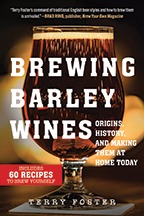
This article is adapted from Terry Foster’s Brewing Barley Wines: Origins, History, and Making Them at Home Today (Skyhorse Publishing, 2024).
All Together Ale
(3 gallons/11 L, all-grain)
OG = 1.139 FG = 1.035
IBU = 90 SRM = variable ABV = 13.4%
This recipe uses the second method discussed in this article — the classic method for brewing barleywines — of an extended three-hour boil to reach the extremely high-gravity wort that will go into the fermenter. Note that the final beer will reduce from 6 gallons (23 L) at the start of the boil to 3.3 gallons (12.5 L) going into the fermenter (and around 3 gallons/11 L to be packaged).
Ingredients
15.5 lbs. (7 kg) Maris Otter pale malt
41 AAU Target hops (180 min.) (3.5 oz./99 g at 11.6% alpha acids)
Yeast nutrient (as directed on package)
3 packs SafAle S-04 yeast
¾ cup corn sugar (if priming)
Step by step
Mash grain at 148–150 °F (64–66 °C), using 5 gallons (19 L) water (ratio 1.2 qt./lb., 2.5 L/kg). At 90 minutes perform a starch-iodine test and mash a further 30 minutes if positive for starch. Run off and sparge with water at about 170 °F (77 °C) to collect 6 gallons (23 L) of wort. Specific gravity of this wort should be about 1.077. Bring to a boil, add the bittering hops and boil down to 3.3 gallons (12.5 L); this may take about 3 hours. Cool to about 70 °F (21 °C), add the yeast nutrient and pitch the yeast. Ferment 10–14 days as close to 70 °F (21 °C) as possible. Rack to secondary for four weeks, rack again and leave for 6–8 months. Keg and force carbonate or prime and bottle, preferably allowing the beer to age a further six months or more. This beer should keep well for several years and I recommend that you do that with at least a portion of it.
KISS Barleywine
(3 gallons/11 L, extract only)
OG = 1.127 FG = 1.036
IBU = 100 SRM = 9 ABV = 12%
This recipe uses the first method discussed in this article of getting all fermentable sugars from malt extract. It’s easier and much less time-consuming than the previous recipe.
Ingredients
12 lbs. (5.4 kg) pale liquid malt extract
23 AAU Simcoe® hops (80 min.) (1.8 oz./50 g at 13% alpha acids)
Yeast nutrient (as directed on package)
3 packs (35 g) SafAle S-04 yeast
¾ cup corn sugar (if priming)
Step by step
Bring 4 gallons (15 L) water to a boil and then remove from heat. Stir 6 lbs. (2.7 kg) extract into the water, taking care to see that all of it is thoroughly dissolved before returning to heat. Add the hops and boil for 60 minutes. Turn off heat and carefully stir in the remaining 6 lbs. (2.7 kg) of extract and boil a further 20 minutes. Cool to about 70 °F (21 °C), add yeast nutrient, oxygenate, and pitch yeast. Ferment 7–10 days as close to 70 °F (21 °C) as possible, rack to secondary for two weeks, rack again and leave for 3–4 months. Keg and force carbonate or prime and bottle, preferably allowing the beer to age a further six months or more. This beer should keep well for several years and I recommend that you do that with at least a portion of it.

